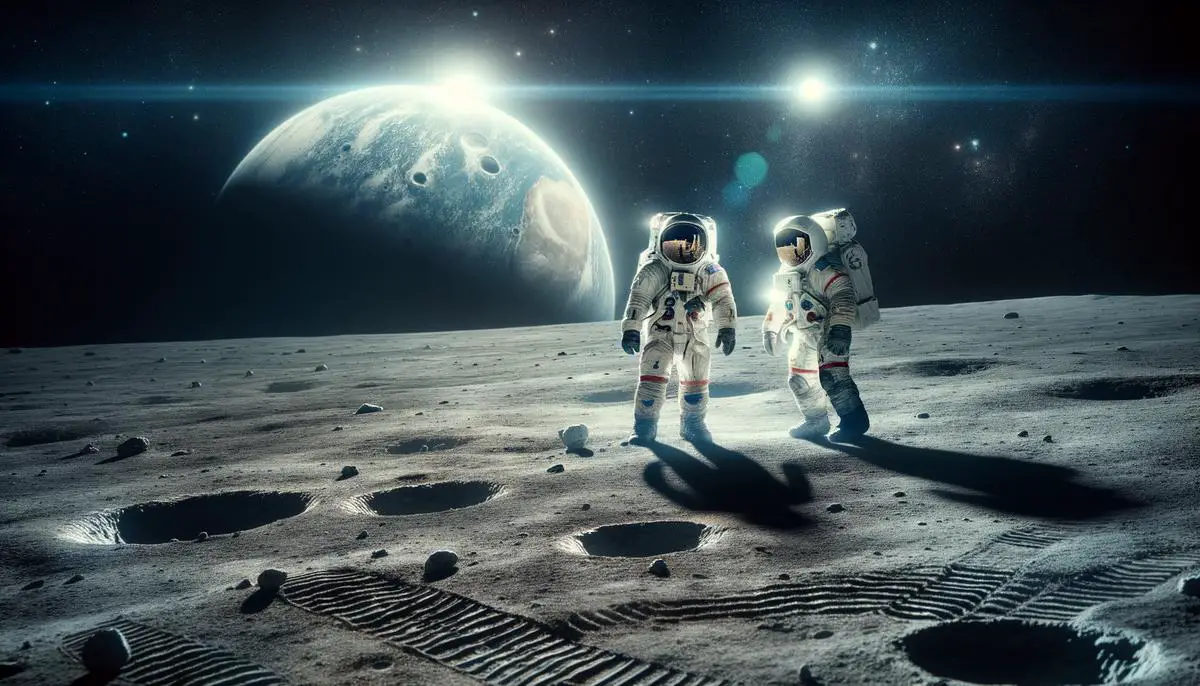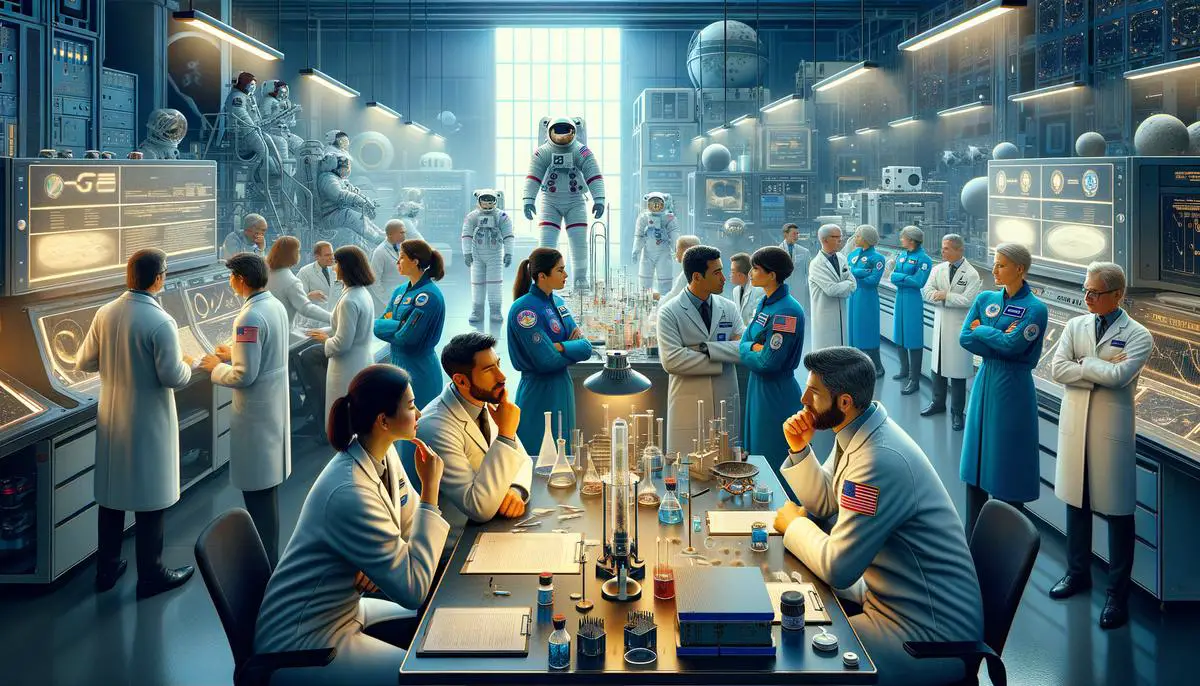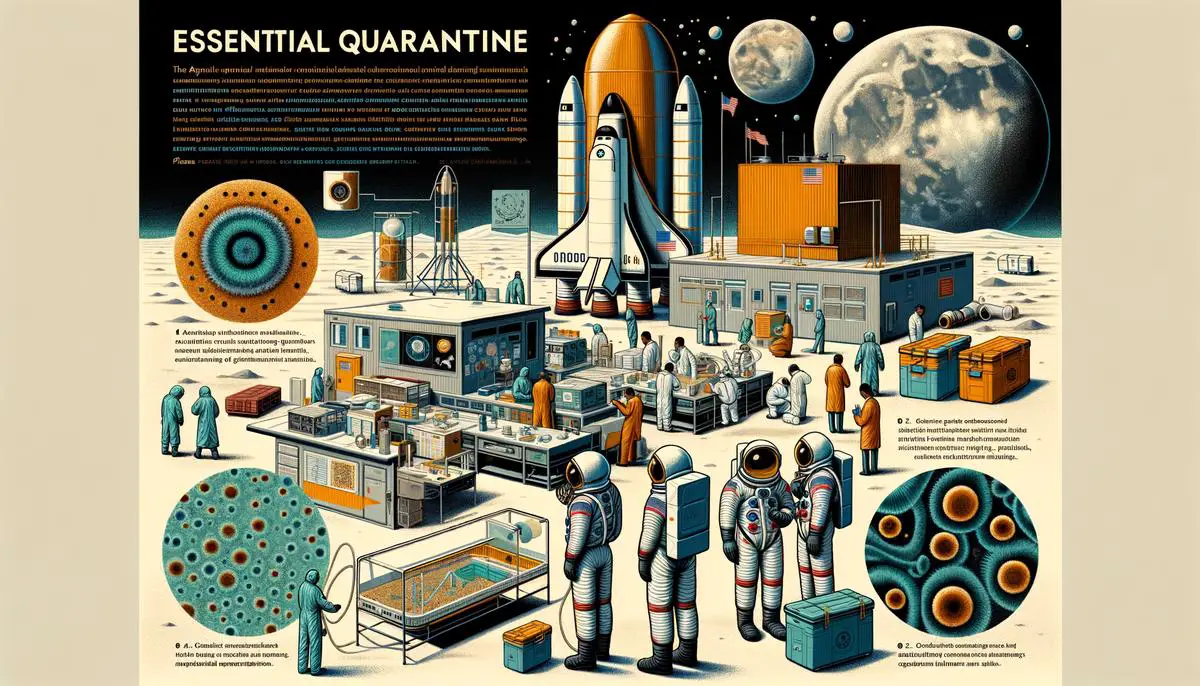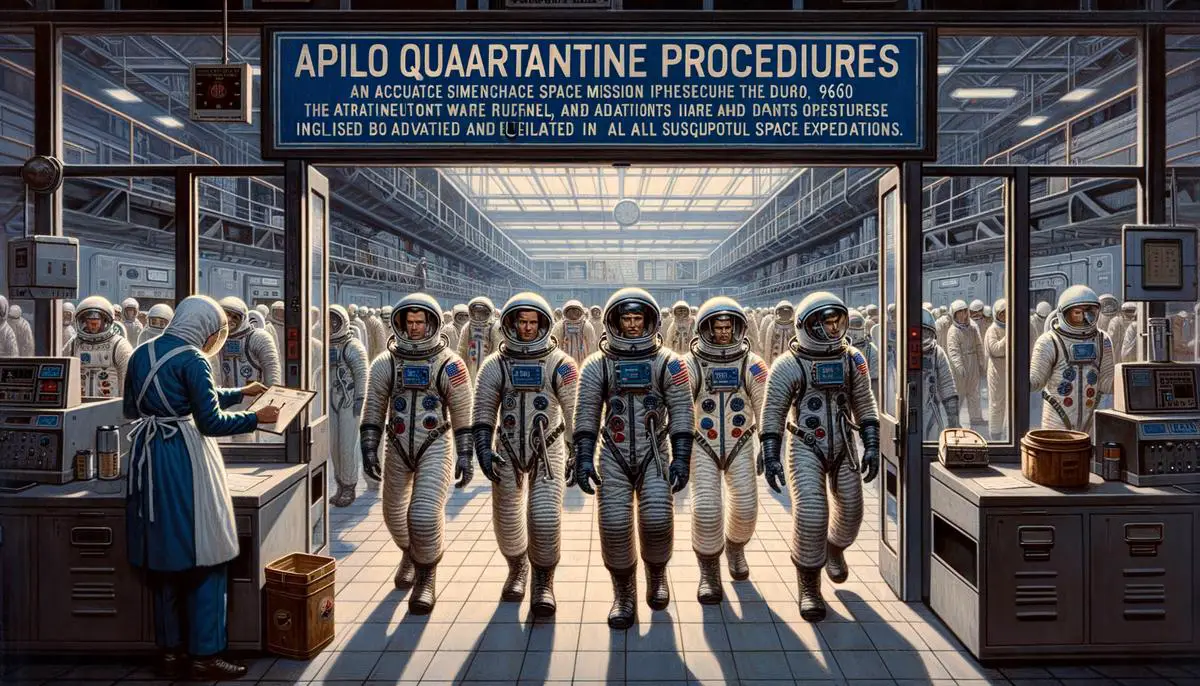When astronauts first left their footprints on the Moon, it marked a monumental achievement in human history. However, before they could celebrate this unprecedented success, they faced an unexpected process: quarantine. This measure, once seen as crucial for protecting Earth from potential unknowns, might appear overly cautious through today’s lens. Yet, at the dawn of space exploration, it underscored a blend of excitement and responsibility. This article explores the depths of quarantine procedures, not just as a historical footnote, but as a pillar of cautious exploration and a testament to the lengths humanity will go to safeguard its home while reaching for the stars.
Contents
Historical Context of Quarantine Procedures
The Apollo missions marked a monumental period in human history, as astronauts first set foot on the Moon’s surface. However, upon their return to Earth, these space explorers were not greeted with immediate celebrations. Instead, they were placed into quarantine. This procedure might seem cautious or even excessive by today’s standards, but during the Apollo era, it was deemed a necessary precaution. The fundamental reasoning behind quarantine procedures post-Apollo missions was the concern over potential lunar pathogens – unknown germs or diseases that could exist on the Moon and potentially harm life on Earth.
Introduction
The exploration of outer space introduces us to the unknown, pushing the boundaries of human knowledge and capability. The Apollo missions of the 1960s and early 1970s, which culminated in humans landing on the Moon, stand as a testament to this spirit of discovery. Yet, with pioneering exploration comes the responsibility to safeguard against possible unknown risks. The quarantine of astronauts following their lunar missions serves as a prime example of such precautions.
Understanding the Need for Quarantine
There was much we did not understand about the Moon before the Apollo missions. Scientists speculated about the lunar environment and whether it harbored life or, conversely, deadly pathogens capable of causing untold damage should they be brought back to Earth. Given the absence of definitive data on the lunar surface’s conditions, NASA decided to err on the side of caution.
Quarantine Measures Implemented
Upon the return of the Apollo 11, 12, and 14 missions, astronauts were immediately placed into a Mobile Quarantine Facility (MQF) – essentially a converted airstream trailer designed to isolate them from the external environment. This quarantine lasted for 21 days, a period considered sufficient to monitor the astronauts for any signs of unknown diseases possibly acquired from the Moon. Additionally, rock samples and other materials brought back from the lunar surface were treated with the same level of caution, stored, and examined in specialized containment facilities.
Rationale Behind the Procedure
The underlying rationale for these quarantine measures was the principle of back contamination control. The goal was to prevent the introduction and spread of extraterrestrial matter that could potentially disrupt Earth’s ecological balance and pose a threat to human health. Such precautions were guided by both the best available scientific knowledge of the time and the imagination of what could be possible, given the limited understanding of extraterrestrial environments.
- Reevaluation and Subsequent Actions
As scientific knowledge of the Moon and its environment expanded, it became clear that the Moon was devoid of life, thus posing no biological threat to Earth. After the Apollo 14 mission, NASA reassessed and eventually lifted the quarantine requirement for later missions, as it was determined that the risk of back contamination was null.
In retrospect, while the quarantine of Apollo astronauts may seem overly cautious, it exemplifies a critical aspect of space exploration and scientific inquiry more generally: the balance between the pursuit of knowledge and the need to mitigate unforeseen risks. This cautious approach underscored the responsibility that comes with exploring unknown frontiers, ensuring that in our quest for discovery, we do not inadvertently compromise the safety of our home planet.
Conclusion
The quarantine procedures following the Apollo missions underscore a period of human history where the excitement of space exploration was tempered with caution and a responsibility towards protecting Earth’s biosphere. This approach reflects a thoughtful consideration of potential risks associated with bringing back extraterrestrial materials, highlighting the importance of preparedness and precaution in the face of the unknown.

Development and Implementation of Quarantine Protocols
As we venture beyond the well-covered aspects of quarantine protocols for the Apollo astronauts, it becomes crucial to understand the intricate process behind developing these protocols. The journey of devising these measures was not merely a response to an immediate need; it was a thorough, meticulously planned endeavor to guarantee the safety of our planet while embracing the spirit of exploration.
The development of quarantine protocols began long before the Apollo 11 mission made its historic landing. Scientists and experts from NASA, in collaboration with international health and space exploration bodies, embarked on a comprehensive study to assess the risks associated with lunar exploration. This phase was critical in identifying potential threats that lunar material could pose to Earth’s biosphere. The collaboration ensured a diverse range of perspectives and expertise, contributing to a more robust and comprehensive quarantine strategy.
One of the fundamental steps in formulating the quarantine protocols was understanding the nature of lunar samples. Extensive research and simulations were conducted to anticipate the properties of lunar soil and potential biological activity. These studies informed the design of the quarantine facilities and the Mobile Quarantine Facility (MQF), ensuring they were equipped to handle the unknown.
Additionally, the development of these protocols entailed detailed planning on the operational procedures for the astronauts immediately upon their return to Earth. This included establishing protocols for their recovery post-landing, ensuring that they were safely transported into the MQF without exposure to the Earth’s environment. The operational intricacies also involved protocols for handling and transferring lunar samples to secure laboratories for analysis, ensuring the utmost caution and precision.
Training played a pivotal role in the successful implementation of the quarantine protocols. Astronauts, along with the recovery and medical teams, underwent rigorous training sessions to familiarize themselves with the procedures. These simulations ensured that each individual understood their role in the process and could execute their duties seamlessly, minimizing the risk of contamination.
The integration of technology was another critical element in developing the quarantine protocols. Innovative solutions were employed to create airtight environments within the MQF and the Lunar Receiving Laboratory. These advancements ensured that any potential pathogens could be contained effectively, preventing their release into the Earth’s atmosphere.
As NASA continued with the Apollo missions, the quarantine protocols were consistently reviewed and refined based on the newfound understanding of the lunar environment and the experiences from each mission. This iterative process underscored the dynamic nature of dealing with the unknown, highlighting the importance of adaptability and rigorous scientific underpinning in space exploration protocols.
Understanding the development and implementation of the quarantine protocols for Apollo astronauts sheds light on the complexities and challenges of protecting Earth’s biosphere while pushing the boundaries of human exploration. It was a journey marked by collaboration, innovation, and an unwavering commitment to safety and scientific integrity.

Life Inside Quarantine for Apollo Astronauts
Life inside the quarantine period for Apollo astronauts was not what most people would expect when thinking about the life of a hero who just came back from the moon. Once the astronauts landed back on Earth, instead of parades or immediate celebrations, they were ushered into a period of isolation. This period, mandatory after their lunar missions, was crucial to ensure that they hadn’t brought back any unexpected and potentially harmful lunar microorganisms.
The Mobile Quarantine Facility (MQF), essentially a converted Airstream trailer, became their temporary home. The astronauts, along with a small support crew, lived in these cramped quarters for up to three weeks. Inside, life was a mix of mundane and surreal. The astronauts had access to creature comforts like beds, a living area, a kitchen, and a bathroom – all the necessities to make their quarantine period as comfortable as possible. It was like a small rolling home, but with the underlying reason for their stay being anything but ordinary.
Everyday activities such as eating, sleeping, and leisure filled much of their time. Meals were a shared activity and provided a semblance of normalcy. However, their food wasn’t home-cooked but rather specially prepared and passed through a contamination-free transfer compartment. Communication with family and NASA personnel was conducted through telephones, ensuring no direct physical contact with the outside world.
Despite the ordinary-seeming daily routines, the astronauts were continually monitored by medical personnel. Health checks were regular to ensure no signs of illness, which might indicate they were affected by unknown pathogens from the moon. This constant vigilance underscored the seriousness of the quarantine measures, contrasting with the day-to-day normalcy of life inside the MQF.
Beyond health monitoring, the astronauts didn’t waste this downtime. They used it to catch up on reports, document their memories of the mission, and prepare for the extensive debriefings and public engagements that awaited them once the quarantine was lifted. These activities were crucial for NASA to gather information and plan future missions.
Interestingly, isolation did not mean disconnection. The astronauts were well aware of the public interest and excitement surrounding their mission. Through TVs and radios, they could catch glimpses of the world celebrating their achievements, a bittersweet experience as they could not partake in these celebrations directly.
Their living quarters, the MQF, was equipped with necessary scientific equipment, allowing them to begin preliminary analysis of their findings and observations from the moon. This period was not just about ensuring Earth’s biosphere’s safety but also about making the most of the time to advance their mission objectives further.
The environment inside the MQF and later the Lunar Receiving Laboratory, where they continued their quarantine period, was highly controlled. Air and waste were carefully managed to prevent any potential contamination. The strict protocols within these facilities were a stark reminder of the quarantine’s purpose, even as life inside tried to mimic normalcy as closely as possible.
In all, the quarantine period for Apollo astronauts was a study in contrasts — ordinary life routines conducted under extraordinary circumstances. It was a time of waiting, reflection, and anticipation. As they lived in their confined, closely monitored spaces, the astronauts were not just heroes returning from a journey to the moon; they were also pioneers on the front lines of ensuring the safety of our planet in the face of the unknown frontiers of space.

Scientific Outcomes and Discoveries from Quarantine Procedures
The quarantine measures put in place during the Apollo missions, aimed to prevent back contamination from the Moon, also created unique conditions for scientific discovery. These measures spurred a series of outcomes that furthered our understanding of the Moon, as well as improved techniques in handling extraterrestrial materials.
One immediate outcome of the quarantine was the advancement in the methods used to examine and store lunar samples. Due to the stringent controls required to keep these samples in pristine condition and avoid contamination of Earth’s biosphere, scientists developed new laboratory protocols. This led to the enhancement of clean room technologies, which are now fundamental in various scientific fields, including pharmaceuticals and semiconductor manufacturing.
In the process of studying the lunar samples within these sophisticated environments, researchers made significant discoveries about the Moon’s composition and history. For instance, they found evidence that the Moon had once been volcanically active and had its own magnetic field in the past. These discoveries were crucial in developing the giant impact hypothesis, the prevailing theory about how the Moon formed.
The quarantine period also emphasized the importance of biosecurity measures in space exploration. The protocols and facilities designed to protect Earth from potential lunar pathogens were pioneering efforts in planetary protection. These measures have informed current guidelines and standards for missions to other celestial bodies, such as Mars, where the risk of contaminating pristine environments with Earth life is a concern.
Moreover, the isolation of astronauts and the rigorous health monitoring they underwent provided valuable data for understanding human resilience in confined environments. This has implications not only for future long-duration space missions but also for understanding the psychosocial impacts of isolation in other circumstances, such as during pandemics or in submarine crews.
Lastly, the entire process of quarantining astronauts and lunar samples allowed for public engagement with space exploration in a new way. It highlighted the meticulous care and scientific rigor that goes into ensuring the safety of both astronauts and the public. The transparency and communication around the quarantine procedures contributed to building public trust and understanding of space exploration challenges and safety measures.
In sum, while the quarantine procedures of the Apollo missions were primarily instituted as a precaution against the unknown, they resulted in a variety of scientific and operational insights. These outcomes have had lasting impacts, contributing to our knowledge of the Moon, advancing laboratory technologies, informing planetary protection policies, enhancing our understanding of human behavior in isolation, and facilitating public engagement with space science.

Impact on Future Space Missions and Planetary Protection Policies
The Apollo quarantine procedures had a significant impact on the ways future space missions approached planetary protection policies. This influence is rooted in the Apollo missions’ pioneering steps in ensuring Earth’s biosphere was shielded from potential extraterrestrial contaminants and vice versa. The rigorous quarantine measures, especially the use of the Mobile Quarantine Facility (MQF) and the meticulous handling of lunar samples, set a precedent for handling materials from other celestial bodies.
The core idea behind Apollo’s quarantine practices was the principle of “back contamination” control, aiming to prevent any lunar microorganisms, if they existed, from entering Earth’s ecosystem. This principle has since evolved into a comprehensive framework for planetary protection that guides not just lunar missions but also missions to Mars and other bodies in the solar system.
One of the direct outcomes of the Apollo quarantine efforts is the enhancement of clean room technologies. The Apollo Lunar Receiving Laboratory (LRL), where lunar samples were initially stored and analyzed, was one of the first of its kind to implement an environment with highly controlled contamination levels. Modern clean room standards and practices in laboratories across the world owe much to the protocols developed for the Apollo LRL. This advancement ensures that samples from space missions are handled in a manner that preserves their scientific integrity while protecting Earth’s environment.
Moreover, the Apollo missions contributed significantly to the development of procedures for examining and storing extraterrestrial materials. The methods pioneered for the lunar samples helped to refine approaches for securing, transporting, and analyzing materials collected from space. These practices are essential for current and future missions that bring samples back to Earth, such as asteroid and Mars sample return missions.
Another key area of influence is in the development of biosecurity measures for space exploration. The Apollo quarantine protocols underscored the need for stringent biosecurity measures to protect both the astronauts and Earth’s inhabitants. This has led to the implementation of rigorous biosecurity protocols in space agencies around the globe, which are continuously updated based on the latest scientific understanding and technological advancements.
Understanding human resilience in confined environments was also an inadvertent outcome of the Apollo quarantine process. The experience of astronauts in isolation, their daily routines, and the psychological impacts of confinement have informed broader studies on human behavior and health in isolated and confined environments. These insights are crucial for planning long-duration space missions, where astronauts will face extended periods in isolation.
Lastly, the public’s engagement and trust in space exploration were bolstered through transparent communication about the purpose and processes of the quarantine measures. By openly discussing the reasons behind the precautions, the space missions cultivated a sense of responsibility and reassured the public about the careful and measured approach to exploring new frontiers.
The legacy of the Apollo quarantine procedures is evident in the sophisticated planetary protection policies that govern today’s space exploration efforts. These policies balance the drive to discover and understand space with the imperative to protect the integrity of Earth’s biosphere and the health of its inhabitants. The foundational work done during the Apollo missions continues to shape the future of humanity’s journey into the cosmos, ensuring that we explore responsibly and safely.

The Apollo astronauts’ quarantine is a vivid illustration of the intricate balance between the thrill of discovery and the solemn responsibility of ensuring Earth’s protection. These practices laid down a foundation that continues to guide space exploration policies. With each new mission beyond our planet, the principles of caution, preparedness, and respect for the unknown remain as relevant as ever. As we stand on the brink of further cosmic exploration, the lessons learned from the past remind us that our journey into the universe is not just about pushing boundaries but also about preserving the well-being of our home planet and its inhabitants.
